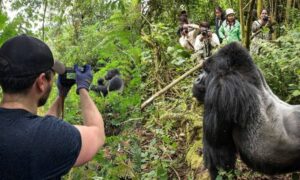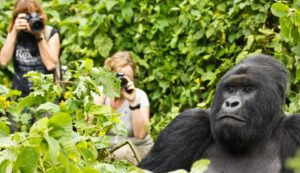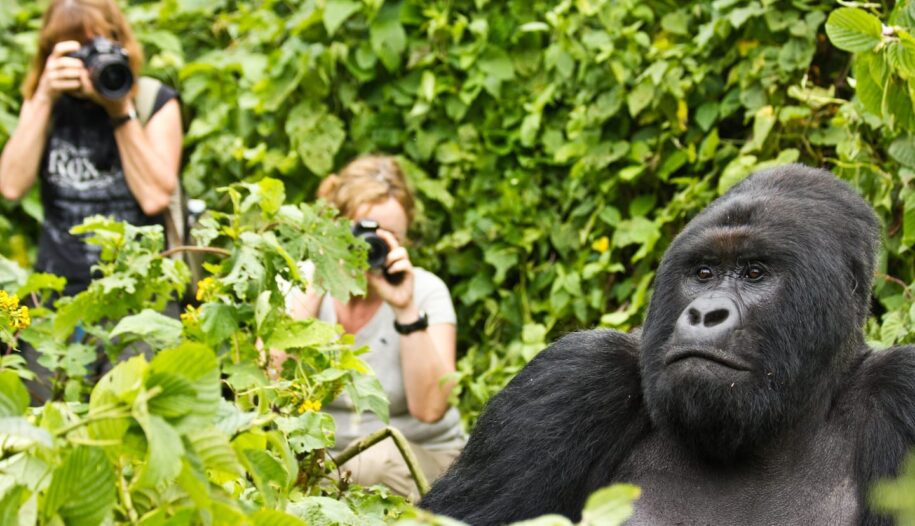Gorilla trekking photography ranks among the world’s most strictly regulated wildlife activities. Authorities in Uganda, Rwanda, and the Democratic Republic of Congo issue a limited number of permits per day.
Each permit grants a single one-hour visit with a habituated gorilla group. During that hour, the question often arises: Is gorilla trekking photography allowed?
The answer is yes, but only within a clear framework designed to protect the animals.
Conservation protocols guide every moment of the trek, including photography.
Tour operators and guides must follow guidelines set by wildlife authorities. These rules reflect years of collaboration between conservationists, researchers, and park management.
People often arrive expecting a documentary-style experience. In reality, gorilla trekking requires patience, restraint, and understanding of animal behaviour.
Before picking up the lens, it’s important to understand what the rules are, why they exist, and how they support long-term gorilla protection.
Gorilla Trekking Photography Rules
Park authorities in Uganda, Rwanda, and the Democratic Republic of Congo enforce strict rules for gorilla trekking photography. These regulations protect gorilla health, reduce behavioural disturbance, and manage visitor conduct.
You must follow these rules from the moment you reach the group until the guide ends the viewing session. Rangers observe your behaviour as closely as they observe the gorillas’.
Each rule exists to maintain a safe and respectful environment for both sides of the experience.
Below are the core requirements for photographing mountain gorillas responsibly and legally.
a. No Flash Photography
Flash triggers defensive or startled reactions in gorillas. The sudden burst of light can disrupt their focus, especially among dominant silverbacks or young juveniles.
You must turn off the flash before reaching the group. Guides often remind participants to check settings during the pre-trek briefing or just before the one-hour visit begins.
Most digital cameras and phones allow manual control over flash functions. Auto-flash must be disabled completely.
b. Maintain a Minimum Distance
The standard minimum distance is 7 meters. This rule applies to both observation and photography. Gorillas may approach, but you must never move closer.
Telephoto lenses help achieve detailed shots without intruding on the group’s space. Staying back also reduces the risk of transmitting airborne infections.
Park rangers monitor spacing throughout the session. If a gorilla moves closer than permitted, they may ask you to shift position quietly and slowly.
c. Follow the One-Hour Rule Strictly
You may only take photos during the official viewing window. That period lasts one hour from the time the guide authorizes the start.
Photography before or after this period is not allowed. Rangers track time precisely and will alert the group when the session ends.
This limit helps preserve the gorillas’ natural rhythms. It also ensures they associate human presence with minimal disruption.
d. Limit Movement and Sound
Avoid sudden gestures, loud clicks, or frequent camera adjustments. Movement draws unwanted attention and can make gorillas feel surrounded.
Use a neck strap or chest harness to keep your camera secure and quiet. Always follow the guide’s cue before repositioning or adjusting the gear.
If your equipment malfunctions, keep still and wait until the group repositions naturally. Do not panic or fumble during active observation.
e. Obey Ranger Instructions at All Times
Rangers and guides read gorilla body language constantly. They may ask you to stop shooting, stay still, or move back.
Always comply immediately without debate. Their primary responsibility is to maintain safety for both people and gorillas.
Photography is a privilege within this context. Professionalism means deferring to those trained in primate behaviour and protection.
What Kind of Camera is allowed for gorilla trekking photography?
You can bring a professional camera, a compact digital device, or a smartphone. What matters more is how you use it and how discreetly you handle it.
Mirrorless systems and DSLRS are both acceptable. They offer superior optics and better low-light performance, which helps in the shaded conditions of montane forests.
Phones are also allowed, but you should keep them in silent mode. Notifications and camera shutter sounds must be turned off before entering the forest.
Camera size matters for movement. Rangers discourage bulky rigs that require set-up or draw attention. Large lenses should be kept attached and ready to shoot.
Tripods, monopods, and selfie sticks are not allowed. They increase clutter, distract from ranger instructions, and sometimes block other participants’ views.
Drones are strictly prohibited. They violate park laws and disturb wildlife. Carrying one into a protected area could result in permit cancellation or fines.
Carrying a weather-sealed camera is a good idea. Forest humidity and sudden rain are common, especially at higher elevations.
If you use a long lens, choose one with image stabilisation. Shooting handheld for an hour requires equipment that balances reach with mobility.
Finally, pack spare batteries and memory cards in sealed, quiet-access pouches. You will not have time to search through noisy backpacks during the session.
Ethical Considerations during Gorilla Trekking Photography
Every permitted visit to a mountain gorilla group carries ethical responsibilities. Conservation authorities monitor human behaviour as closely as they monitor the animals.
Gorillas live under constant ecological pressure. Habitat fragmentation, reduced food corridors, and airborne disease exposure make them highly sensitive to human contact.
Permits include strict hygiene protocols. You must sanitise your hands before the trek and report any symptoms. Park staff may delay access if health concerns arise.
Each gorilla group accepts human presence through controlled habituation. This conditioning process allows daily contact without disrupting core behaviours such as feeding, parenting, and rest.
Even within habituated groups, dominant males remain alert to noise, posture, and movement. Photographers must avoid quick gestures, camera noise, or prolonged eye contact.
Gorillas interpret direct eye contact as tension. Focus on framing without confrontation. Follow the guide’s signals when adjusting position or line of sight.
Avoid crowding a single animal. Guides may instruct spacing changes to prevent group distress, especially around infants or during feeding.
Spend time observing without the camera. Short breaks from shooting reduce distraction and show respect for the animals’ rhythm and space.
Ethical conduct supports long-term access to these groups. It protects both the gorillas and the integrity of the trekking program itself.
Tips for Better Gorilla Trekking Photography
Gorilla trekking photography requires quick thinking, technical readiness, and situational awareness. You cannot direct a scene. You must respond to it with control and restraint.
Below are practical, field-tested tips that help you take high-quality images without disrupting the animals or the group.
Use a Telephoto Lens
A 200mm to 400mm focal length works well. It allows tight framing from a safe distance and gives flexibility when subjects move deeper into the vegetation.
Avoid constant zooming. Find a balanced composition, then wait for subtle shifts in gesture, expression, or eye contact. That patience pays off more than rapid shots.
Set a High ISO Before You Arrive
Forests often limit natural light, especially under a closed canopy. Set your ISO between 800 and 3200 depending on your camera’s noise handling.
Use aperture priority mode if you’re not fully manual. Keep the aperture wide and adjust exposure compensation if gorillas appear underexposed against bright leaves.
Focus on the Eyes
Sharp eyes connect the viewer to the subject. Use single-point autofocus and place it directly over the eyes. Recompose after locking focus if needed.
Avoid face detection modes. They often struggle with deep shadows, overlapping bodies, and non-human facial features.
Control Your Shutter Sound
Some mirrorless cameras allow silent shooting modes. Activate this before the trek. If your camera clicks loudly, shoot sparingly and at key moments only.
The quieter your gear, the more invisible you become. That makes others comfortable and helps reduce gorilla tension during your session.
Avoid the Burst Mentality
Shooting in continuous mode drains batteries and creates unnecessary movement. Instead, anticipate. Watch the group, and press the shutter only when something develops.
If a juvenile climbs or a silverback rests, hold still. Let the scene unfold before responding. Movement invites better shots than reaction.
Keep Gear Light and Accessible
Use one camera body and one lens. Avoid changing lenses during the session. You will not have time or space to manage accessories.
Carry your gear using a chest sling or shoulder strap. Keep batteries and cards in a quiet pouch. Noise during reloading distracts both people and animals.
Conclusion
Gorilla trekking photography tests both discipline and perception. The best results come from patience, timing, and respect for the structure that protects access to these wild animals.
Every decision in the forest carries weight. Understanding when to wait, when to move, and when to stop creates space for images with meaning and presence.
Wildlife photography holds value only when the subject comes first. Gorilla trekking demands that priority. Those who understand that produce stronger work and support conservation by doing so.


Leave a Reply
You must be logged in to post a comment.